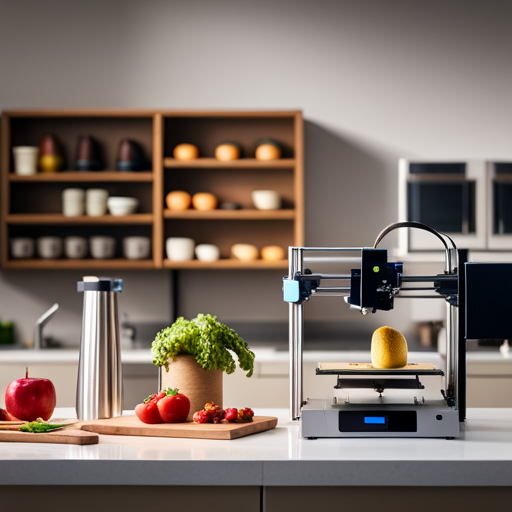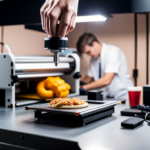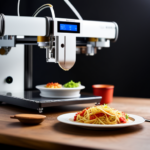Did you know that the global 3D food printing market is projected to reach $525.6 million by 2026?
With the increasing popularity of 3D food printing technology, finding a budget-friendly option can be challenging.
This buyer’s guide provides a comprehensive overview of the key features to consider, budget-friendly options, performance, user-friendly design, maintenance costs, and customer recommendations.
Whether you’re a culinary enthusiast or a professional chef, this guide will help you make an informed decision.
Understanding 3D Food Printing Technology
One must understand the principles and processes of 3D food printing technology to make informed decisions when considering purchasing a budget-friendly food 3D printer.
3D food printing technology has evolved to encompass a wide range of applications, from creating intricate confectionary designs to personalized nutrition with precise ingredient control. The printing process efficiency is a critical factor to consider, as it directly impacts production time and cost-effectiveness. Understanding the printing process efficiency involves evaluating factors such as printing speed, layer resolution, and material waste reduction.
When exploring 3D food printing applications, it becomes evident that the technology offers versatility in creating complex geometries and customized designs, making it suitable for culinary professionals and food enthusiasts alike. Additionally, the ability to replicate intricate designs with high precision underscores the potential for artistic expression and commercial production. Furthermore, the integration of sustainable and nutritious ingredients aligns with the growing demand for personalized and health-conscious food options.
Key Features to Consider
When considering purchasing a budget-friendly food 3D printer, it is essential to carefully evaluate key features that align with specific production needs and quality standards. One of the primary considerations is the availability of cost-effective models. It is important to assess the initial cost of the printer, as well as the long-term expenses associated with maintenance, energy consumption, and the cost of 3D printing materials. Look for printers that offer a balance between affordability and operational efficiency to ensure a cost-effective investment over time.
Another crucial feature to consider is the compatibility with a wide range of 3D printing materials. The ability to use various food-grade materials such as chocolate, sugar, dough, and other edible substances is essential for versatility in food creation. Additionally, the printer should support materials that meet safety and quality standards for consumption. Evaluating the compatibility and availability of these 3D printing materials is vital to ensure the successful production of a diverse range of food items.
Budget-Friendly Options
An array of budget-friendly food 3D printers is available in the market, offering cost-effective solutions for food creation through additive manufacturing technology. When considering budget-friendly options, it’s important to look for affordable models that provide the necessary features for food printing without compromising on quality.
Some cost-effective choices include printers that offer a decent range of food materials compatibility, simple yet reliable printing mechanisms, and user-friendly interfaces. These affordable models can cater to the needs of small-scale food businesses, culinary enthusiasts, and educational institutions seeking to explore the potential of 3D food printing without investing in high-end equipment. Despite being budget-friendly, these printers can still deliver satisfactory results in terms of food customization and design flexibility.
Transitioning into the subsequent section about ‘performance and output quality’, it’s essential to examine how these budget-friendly options fare in terms of their ability to consistently produce high-quality printed food items and meet the demands of various food printing applications.
Performance and Output Quality
Budget-friendly food 3D printers demonstrate their performance and output quality through consistent production of high-quality printed food items. They achieve this by ensuring output precision and material compatibility, which are essential for delivering reliable and satisfactory results. When evaluating the performance and output quality of budget-friendly food 3D printers, consider the following:
-
Consistency: The ability to consistently produce high-quality food items without compromising on taste or texture.
-
Detail: The printers’ capability to render intricate designs and patterns with precision, enhancing the visual appeal of the printed food.
-
Versatility: The capacity to work with a variety of food materials, allowing for a wide range of culinary creations.
-
Reliability: The reliability of the printer in delivering consistent results over time, ensuring that it remains a valuable long-term investment.
These factors play a crucial role in determining the overall performance and output quality of budget-friendly food 3D printers, ultimately impacting their value and suitability for various culinary applications.
As we delve into the user-friendly design and interface of these printers, it becomes evident that their performance and output quality are closely intertwined with their ease of use and accessibility.
User-Friendly Design and Interface
Demonstrating a user-friendly design and interface, budget-friendly food 3D printers streamline the process of creating culinary delights while ensuring ease of operation and accessibility for users. The user interface of these 3D printers is designed with simplicity in mind, featuring intuitive controls and clear navigation to facilitate a seamless user experience.
The design aesthetics of these printers are also carefully crafted to enhance user interaction, with attention to ergonomic principles for comfortable usage and visually appealing exteriors that complement modern kitchen environments.
Additionally, budget-friendly food 3D printers prioritize user-friendly features such as easy-loading printing cartridges, straightforward maintenance procedures, and clear instructional guides. These elements contribute to a hassle-free experience for users, allowing them to focus on unleashing their culinary creativity without being hindered by technical complexities.
Furthermore, the interface of these 3D printers often includes preset food templates and customizable settings, empowering users to effortlessly personalize their creations.
Maintenance and Long-Term Costs
When considering budget-friendly food 3D printers, it’s essential to assess the maintenance and long-term costs associated with their upkeep.
This includes understanding the ongoing expenses related to printer maintenance and any potential need for replacement parts.
Additionally, evaluating the longevity and durability of the printer is crucial in determining its overall cost-effectiveness.
Printer Upkeep Expenses
Discussing the maintenance and long-term costs of food 3D printers is essential for understanding their overall affordability and investment value.
Upkeep costs and consumable expenses play a crucial role in the total cost of ownership for a 3D food printer. When considering printer upkeep expenses, it’s important to consider the following:
-
Consumable Costs: Factor in the expenses for edible printing materials, such as food-grade filaments or powders, which can significantly impact the overall operational costs.
-
Maintenance Kits: Regular maintenance is necessary for optimal printer performance. The cost of maintenance kits, including replacement parts and cleaning supplies, should be taken into account.
-
Energy Consumption: Analyze the energy consumption of the printer to estimate long-term operational expenses.
-
Warranty and Support: Consider the costs associated with extended warranties, technical support, and potential repair services to ensure budget alignment for ongoing support.
Longevity and Durability
Continuing the consideration of longevity and durability, it is crucial to evaluate the maintenance and long-term costs associated with food 3D printers. When assessing a food 3D printer’s longevity, reliability, and durability, it’s essential to consider the lifespan of its components and the frequency of required maintenance.
Understanding the long-term costs, including replacement parts, ongoing maintenance, and potential repairs, is vital for budget-conscious buyers. Some food 3D printers may have a lower initial cost but higher long-term expenses due to frequent maintenance or shorter lifespans of components. Therefore, it’s important to weigh the upfront investment against the projected long-term costs to ensure that the chosen 3D printer aligns with both budget and durability requirements.
Evaluating these factors can help in making an informed decision when selecting a budget-friendly food 3D printer.
Transitioning into assessing customer reviews and recommendations, it’s crucial to consider firsthand experiences with the printers.
Customer Reviews and Recommendations
After carefully evaluating customer feedback and recommendations, it is evident that budget-friendly food 3D printers have garnered significant interest among consumers. The overall customer satisfaction with these printers has been notably high, with many users expressing their delight in being able to create customized food items conveniently. The product usability of these 3D printers has also been praised, as they are designed to be user-friendly, making the process of food printing accessible to a wide range of individuals, including home cooks and professional chefs.
Customers have raved about the seamless integration of the printers with various recipe apps, allowing them to effortlessly bring their culinary creations to life.
Many users have expressed their satisfaction with the versatility of the printers, enabling them to experiment with different ingredients and textures, leading to a newfound sense of creativity in the kitchen.
The compact size of the printers has been a highlight for numerous consumers, as it fits seamlessly into their kitchen space without causing any inconvenience.
Several customers have commended the responsive customer support provided by the manufacturers, emphasizing the value of prompt assistance in enhancing their overall experience.
Frequently Asked Questions
Can 3D Food Printers Be Used to Create Gluten-Free or Other Dietary Restriction-Compatible Foods?
Yes, 3D food printers can create gluten-free and other dietary restriction-compatible foods. They offer customized diets, maintain nutritional value, and can replicate taste and texture. These printers provide a versatile solution for catering to various dietary needs.
Are There Any Safety Concerns or Potential Health Risks Associated With 3D Printed Food?
When considering 3D printed food, it’s essential to address potential risks, food safety, regulatory concerns, and nutritional value. Ensuring proper material safety, hygiene, and adherence to food regulations is crucial for consumer health.
How Long Does It Typically Take to Print a Meal Using a Budget-Friendly 3D Food Printer?
Printing time for a 3D food printer varies based on complexity and customization. Like a culinary symphony, the process can range from minutes to hours. Meal customization and intricacy are essential factors affecting the printing duration.
Can 3D Food Printers Accommodate Different Cuisines and Cooking Styles?
3D food printers can accommodate various cuisines and cooking methods, making them versatile for cultural adaptations. These printers can handle a wide range of ingredients and create dishes from different culinary traditions, catering to diverse tastes and preferences.
Are There Any Specific Food Materials or Ingredients That Are Not Compatible With Budget-Friendly 3D Food Printers?
When considering food compatibility and printing limitations with budget-friendly 3D food printers, it’s imperative to note that certain ingredients, such as highly liquid or extremely viscous materials, may pose challenges during the printing process.
Conclusion
In conclusion, the budget-friendly food 3D printers serve as a symbol of technological advancement and innovation in the culinary world.
With their ability to create intricately designed and customized food items, these printers offer a new level of creativity and efficiency in food production.
By considering key features, performance, user-friendly design, maintenance costs, and customer reviews, buyers can make informed decisions to bring this symbol of innovation into their kitchens.


